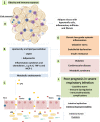The Weight of Obesity in Immunity from Influenza to COVID-19
- PMID: 33816341
- PMCID: PMC8011498
- DOI: 10.3389/fcimb.2021.638852
The Weight of Obesity in Immunity from Influenza to COVID-19
Abstract
The severe acute respiratory syndrome coronavirus 2 (SARS-CoV-2) has emerged in December 2019 and rapidly outspread worldwide endangering human health. The coronavirus disease 2019 (COVID-19) manifests itself through a wide spectrum of symptoms that can evolve to severe presentations as pneumonia and several non-respiratory complications. Increased susceptibility to COVID-19 hospitalization and mortality have been linked to associated comorbidities as diabetes, hypertension, cardiovascular diseases and, recently, to obesity. Similarly, individuals living with obesity are at greater risk to develop clinical complications and to have poor prognosis in severe influenza pneumonia. Immune and metabolic dysfunctions associated with the increased susceptibility to influenza infection are linked to obesity-associated low-grade inflammation, compromised immune and endocrine systems, and to high cardiovascular risk. These preexisting conditions may favor virological persistence, amplify immunopathological responses and worsen hemodynamic instability in severe COVID-19 as well. In this review we highlight the main factors and the current state of the art on obesity as risk factor for influenza and COVID-19 hospitalization, severe respiratory manifestations, extrapulmonary complications and even death. Finally, immunoregulatory mechanisms of severe influenza pneumonia in individuals with obesity are addressed as likely factors involved in COVID-19 pathophysiology.
Keywords: COVID-19; immunity; immunopathology; obesity; severe influenza.
Copyright © 2021 Andrade, Gualberto, Rezende, Percegoni, Gameiro and Hottz.
Conflict of interest statement
The authors declare that the research was conducted in the absence of any commercial or financial relationships that could be construed as a potential conflict of interest.
Figures


References
Publication types
MeSH terms
Substances
LinkOut - more resources
Full Text Sources
Other Literature Sources
Medical
Miscellaneous

